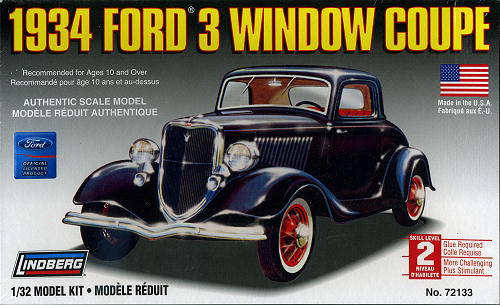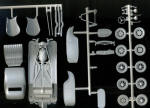
Lindberg 1/32 1934 Ford Coupe
| KIT #: | 72133 |
| PRICE: | $7.00 is what I paid |
| DECALS: | None included |
| REVIEWER: | Scott Van Aken |
| NOTES: | Curbside |

| HISTORY |
The Model B was a Ford automobile with production starting with model year 1932 and ending with 1934. It was a much updated version of the Model A and was replaced by the 1935 Ford Model 48. Strictly speaking, the Model B was a four-cylinder car with an improved version of the engine used in the Model A, but Ford also began producing a very similar car with Ford's new Flathead V‑8 engine. The V‑8 car was marketed as the Model 18, though it is commonly called the Ford V‑8, and, other than the engine, is virtually indistinguishable from the Model B.
Up to this time, Ford had produced only one "model" at each time with range of body options and retained the idea of a single basic platform, despite the engine choice and two associated model designations. (This explains why the colloquial name "Ford V‑8" by itself was sufficiently descriptive in the early 1930s; it was the Ford with a V‑8, unlike in later decades, when the paradigm of various models to a make became universal.) Model B and Model 18 Fords came in a large variety of body styles: two-door roadster, two-door cabriolet, four-door phaeton, two-door and four-door sedans, four-door 'Woodie" station wagon, two-door Victoria, two-door Convertible Sedan, Panel and Sedan Deliveries, five-window coupe, a sport coupe (stationary softtop) and the three-window Deluxe Coupe. Prices ranged from $460 for the roadster and the coupe's $490 to the $650 convertible sedan. Production totals numbered from 12,597 for the roadster to 124,101 for the two-door sedan. Nowadays, the roadster and coupe are most sought after, as these body styles are popular for streetrods and intact examples have become rare.
The Model 18 was the first low-priced, mass-marketed car to include a V‑8 engine, an important milestone in American automotive history. The V‑8 was rated at 65 hp (48 kW) when introduced, but power increased significantly with improvements to the carburetor and ignition in later years. This engine choice was more popular than the four-cylinder, which was essentially a variant of the Model A engine with improvements to balancing and lubrication. In both models the fuel tank was located in the lower rear of the car, as is typical in modern cars, rather than in the cowl as in the Model A and late Model T, requiring Ford to include an engine-driven fuel pump rather than rely on gravity feed.
Today, the 1932 Model B is a highly collectible car that people will pay thousands of dollars to restore to exact original style. During the WWII period the Model Bs and V‑8s were frequently altered into hot rods. This continued into the 1960s on a large scale. Since the 1970s, 1932 bodies and frames have been reproduced either in fiberglass or lately in steel, which has helped resolve bodywork shortages, and increased the number of "rods" being created or restored. Those that are made are often very expensive. A typical auto-show hot rod may be $60,000 or more.
The 1933 revision of the car was substantial, especially considering how important the 1932 change had been. For its second year, the Ford's wheelbase was stretched from 106 in (2692 mm) to 112 in (2845 mm) on a new crossmember frame. The grille was revised, gaining a pointed forward slope at the bottom which resembled either a shovel or the 1932 Packard. Both the grille and hood louvers curved down and forward.
Power from the V‑8 was also increased to 75 hp (56 kW) with a revised ignition system. The four-cylinder engine continued unchanged, but was referred to (by some) as the Model C. Ford Motor Company never referred to its "Improved Four-Cylinder engine" as a "Model C" engine. This is a common misconception due the introduction of a larger counterbalanced crankshaft during the Model B engine production, and the letter "C" casting mark on most, but not all, of the Model B heads. (Model A part number suffix was ‑A, Police Special High Compression head part number suffix was ‑b, and there was a fairly large letter "B" casting mark about the center of the head.) Total sales for the model year were up to 311,113.
The 1934 Ford (called the Model 40A and subject of this kit) was not as substantial a model year change as the previous two years had been. Noticeable changes included a flatter grille with a wider surround and straight hood louvers. V‑8 output was again upped, this time to 85 hp (63 kW), and the four-cylinder Model B engine was in its last year, as was the Victoria body style.
| THE KIT |
 For
many years, Lindberg produced a considerable number of car kits in 1/32 scale.
These were all curb sides and thanks to the revitalization of the company under
the J Lloyd banner, these have been produced over the last few years.
Thankfully, J Lloyd has paid attention to the condition of the molds and the
quality of the parts being produced is exceptional for kits that are not exactly
new. As I'm always on the look for inexpensive kits, when I saw this on the
shelves at the LHS, I picked it up.
For
many years, Lindberg produced a considerable number of car kits in 1/32 scale.
These were all curb sides and thanks to the revitalization of the company under
the J Lloyd banner, these have been produced over the last few years.
Thankfully, J Lloyd has paid attention to the condition of the molds and the
quality of the parts being produced is exceptional for kits that are not exactly
new. As I'm always on the look for inexpensive kits, when I saw this on the
shelves at the LHS, I picked it up.
This kit is molded in white styrene and has little in the way of sink areas, ejector pin marks or flash. Many of the larger parts have the part number molded into it, though it will be invisible once the car is build. These kits were designed before the advent of one piece bodies so the builder will have to assemble the body, which is five parts, not counting the grille. The chassis is one piece with the fenders, chassis detail and floor all molded as one. Tires have the wire wheels molded in place and are two piece affairs. Smaller bits like headlights and tail lights which are chrome on the real car, are in white plastic. There are no chrome bits included. Fortunately, we have Bare Metal Foil or Chrome paint from Alclad II to help duplicate this feature.
Instructions are on a single side of standard paper with two exploded views that list the various part numbers. Typical of old kits, there are 15 construction steps written out. Fortunately, the drawings are easy to follow as the print is right on the verge of being illegible. No color information is given anywhere in the instructions. That needs to be gleaned from the box art.
| CONCLUSIONS |
AI know that both scale and subject are not for everyone. However, 1/32 fits in with many military dioramas and is a good one for those who don't have the shelf space.
| REFERENCES |
http://en.wikipedia.org/wiki/1934_Ford
April 2010
If you would like your product reviewed fairly and quickly, please
contact
me or see other details in the
Note to
Contributors.